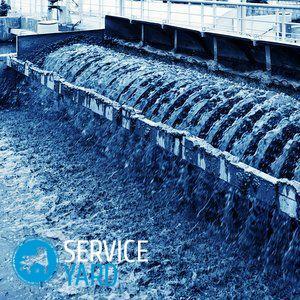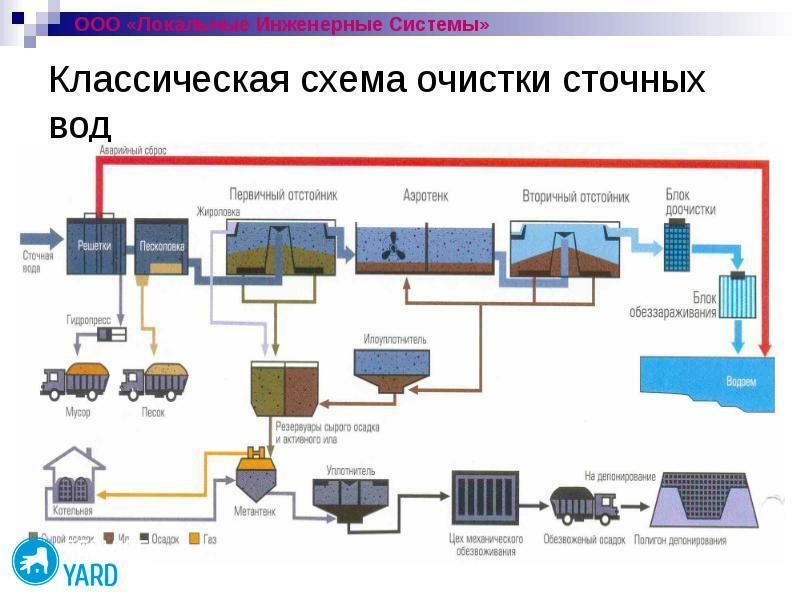
- What is wastewater?
- Classification of impurities
- Cleaning standards
- Methods for cleaning domestic waste water
- Choosing the right cleaning device
The presence of a water pipe is one of the most important signs of a building's well-being. And if there is a water supply, there must necessarily be a system of water disposal and discharge of sewage from impurities. If it is a central sewage system, the sewage treatment and waste disposal is carried out by the Vodokanal. In his own house, the issue of the disposal and regeneration of waste water is entirely the responsibility of the owner of the house-building. Let's consider the most widespread ways of regeneration of the fulfilled liquids.
to the contents ↑What is wastewater?
Sewage is the name for water, which, when used for industrial or domestic use, has been contaminated. To the same category include melted and rainwater, which were collected from the surface of the soil.
to the contents ↑Classification of contaminants
For the correct selection of treatment equipment, you need to have a basic knowledge of the types of contamination. Only in full understanding of what you will get rid of, sewage treatment will be really effective. All pollution is divided into three categories.
Mineral
These are all kinds of impurities of inorganic origin - soil particles, salts and other chemical inorganic compounds.
Organic
These impurities contain animal and vegetable residues, as well as organic chemical compounds( eg polymers).
Biological
Spent fluid contains various microorganisms. In this case, it acts as a nutrient medium for microorganisms.
Important! As a rule, all the listed components are present in the waste waters in different proportions. For example:
- the ratio of organic and inorganic impurities in conventional domestic effluents is 3: 2;
- the percentage of the biological component and its composition depends on the type of effluents and the presence of microorganisms in the environment.
Cleaning standards
The selected wastewater treatment technology should provide the required degree of water treatment. At the same time, strict standards for the purification of waste water are accepted only for industry.
Important! The concentration of each substance in the purified water is regulated. For example, the release of water from iron should be done in such a way that its content at the outlet does not exceed 0.1 mg / l.
to the table of contents ↑Methods for cleaning domestic waste water
Using modern methods of water regeneration allows you to reuse it. Naturally, not for drinking or cooking, but for household needs - watering, washing cars or garden paths.
For clearing of impurities of domestic wastewater, such methods of water purification are used:
- Mechanical - sedimentation, filtration.
- Physicochemical - the use of adsorption, coagulation, and the release of water from impurities when adding various chemicals.
- Biological - the use of special bacteria for the treatment of waste water.
Consider what these wastewater treatment technologies are.
Mechanical
Basically, this method is used in the initial stage of sewage regeneration. The main task of this stage is to free them from large impurities. Such filtration is carried out by the method of gravity settling and installation of filters with coarse cleaning.
Important! Mechanical methods make it possible to purify sewage water by 60-70%.Widely used and defending. With the help of settling, petroleum products are removed from the water. For this reason, the mechanical method of removing impurities is used in car washes and refineries.
A mechanical method is also used for storm water, since they contain a lot of large debris. In addition, in the storm sewers use sand catchers, which do not allow sand to enter the system. 
Types of wastewater treatment: biological method
Biological methods are used to clean domestic sewage. There are the following types of biological types:
- Biofilters. The essence of the method is in the transmission of water through a layer of coarse material( sand, gravel), covered with the finest bacterial film. When leakage of sewage through the bacterial film, intensive biooxidation reactions occur.
- Biological ponds. These are natural or artificially created reservoirs in which wastewater is purified by natural bioprocesses. As a rule, bioprud is used for post-treatment of waste water, which has already undergone initial mechanical cleaning. Usually the depth of such water bodies is small - does not exceed 1.0 m, they are well warmed by the sun.
Important! In ponds there are various microorganisms, vital activity of which is provided due to organic substances. In biopudes both anaerobic and aerobic processes occur( and, for aerobic processes, atmospheric or artificially supplied oxygen can be used).
- Aerotanks are closed reservoirs for biological treatment of effluents, with forced oxygen supply. In these settings, the activated sludge is used. In the composition of this substance there are bacteria and protozoa( infusoria, amoeba).The mixture contributes to the qualitative treatment of effluents.
Chemical and physicochemical methods of
These methods are used very rarely in everyday life. More often, chemical and physicochemical methods are used to purify industrial waters:
- The method of coagulation involves the coalescence of small particles of impurities into larger ones. The essence of coagulation is the interaction of the liquid and the reagent being purified( flocculant or coagulant).
- The adsorption method helps to separate most of the harmful impurities contained in the waste water.
Important! The impurities contained in the water are transformed into harmless forms.
Chemical treatment of sewage consists in treatment of primary purified water with solutions of chlorine, potassium permanganate and other chemical compounds that can destroy pathogens.
to the contents ↑Choosing the right cleaning device
Choosing a device for wastewater cleaning is one of the most important aspects in sewage disposal.
Choose a cleaning installation, guided by such criteria:
- Long working life, reliability. Ideal option, when the life of the entire building is the same as the resource of the treatment plant.
- Ease of maintenance and use.
- Quality of waste water treatment.
- Productivity( ability to completely recycle all household wastewater).
The release of liquid from the additives contained in it is a laborious process that requires compliance with all sanitary and technological norms. The choice of this or that method depends on the type of waste water, their quantity, and also on the content of contaminants.



